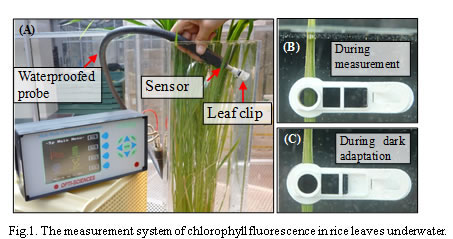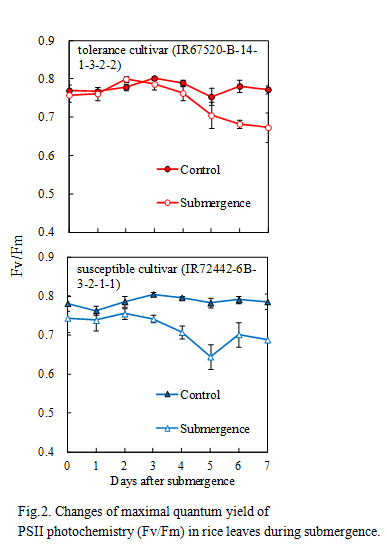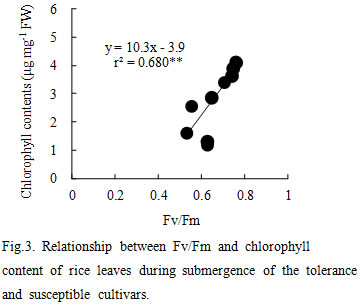Simple and rapid measurements of photosynthetic activity in submerged rice by measuring chlorophyll fluorescence emissions
Description
Submerged rice plants experience low oxygen and irradiance underwater, causing severe visible damages and photosynthesis inhibition. In recent years, the measurement of chlorophyll fluorescence emissions using a Pulse Amplitude Modulation (PAM) instrument has become a powerful tool for quick and non-invasive evaluation of the photosynthetic activity and photoinhibition in plants. However, measurements of chlorophyll fluorescence in rice underwater have not been developed. Previous studies on photosynthetic activity of submerged rice plants technically involved only numerical values measured above water (i.e. aerobic conditions) as measurements were taken after the removal of plants from submergence instead of measuring it while submerged. By doing so, it discounted the effects of environmental changes from anaerobic to aerobic conditions. The objective of this study is to develop a method for evaluating photodamage directly under water by analyzing chlorophyll fluorescence in leaves using a portable chlorophyll fluorescence meter with a waterproof probe.
Two rice (Oryza sativa L.) cultivars differing in their response to submergence were compared, namely: (1) a tolerance cultivar IR 67520-B-14-1-3-2-2 (IR67520), and (2) a susceptible cultivar IR72442-6B-3-2-1-1 (IR72442). Twenty-three-day-old seedlings were submerged in 80-cm-deep water for 14 days. The maximal quantum yield of PSII (Fv/Fm) of the dark-adapted leaves was measured using a portable chlorophyll fluorometer (OS5p; Opti Sciences Inc., USA) with the probe wrapped tightly with polyolefin to become waterproof (Fig.1A). Dark-adaptation leaf clips were mounted on the leaves before readings were taken (Figs. 1B and 1C). During submergence, Fv/Fm of the submerged leaf decreased earlier in IR72442 than in IR67520 compared to control plant (Fig.2). Fv/Fm showed a significant positive correlation with chlorophyll content during submergence (Fig. 3). At 14 days after submergence, the water in the tank was lowered to a 4-cm depth. Although Fv/Fm of the newly developed leaves during submergence in submerged IR67520 increased substantially from 2 days post-submergence, IR72442’s decreased because of leaf chlorosis and all plants eventually died (data not shown). Therefore, it can be inferred that the tolerance cultivar coped with submergence by inhibiting photodamage and maintaining high chlorophyll content in the leaves.
The chlorophyll fluorescence meter with a waterproof probe can be utilized for the measurement of photochemistry reactions in rice leaves under floodwater. In our method, Fv/Fm can be measured in less than one minute per plant in air and underwater, with the results expected to become valuable screening tools for research and breeding programs for the improvement of submergence resistance in rice.
Figure, table
- Affiliation
-
Japan International Research Center for Agricultural Sciences Crop, Livestock and Environment Division
- Classification
-
Administration A
- Research project
- Program name
- Term of research
-
FY 2011 (FY 2011-FY 2015)
- Responsible researcher
-
Sakagami Junichi ( Kagoshima University )
KAKEN Researcher No.: 70399369 - ほか
- Publication, etc.
-
1.Sone et al. (2012) J. Agron. Crop Sci. 198(2):152-160
- Japanese PDF
-
2011_06_A4_ja.pdf118.21 KB
- English PDF
-
2011_06_A4_en.pdf223.86 KB



